75 Years German Basic Law

#strongertogether
The Basic Law for the Federal Republic of Germany was adopted on May 23, 1949. Even after 75 years, its significance for German society is undisputed. At that time, it excluded the people in the Soviet occupation zone and Saarland. Today, it is valid for all Germans. This process was initiated by the occupying powers – the United States, Great Britain, and France – and from 1946 onwards the states established in the western occupation zones.
From the headquarters of the U.S. Armed Forces in the I.G. Farben building, the Western Allies initiated and supported the restructuring of Germany after World War II. They played a decisive role in the establishment of a free, democratic, and social federal state.
On May 12, 1949, the military governors Lucius D. Clay (USA), Sir Brian H. Robertson (UK), and Pierre Koenig (France) approved the Basic Law in the I.G. Farben building.
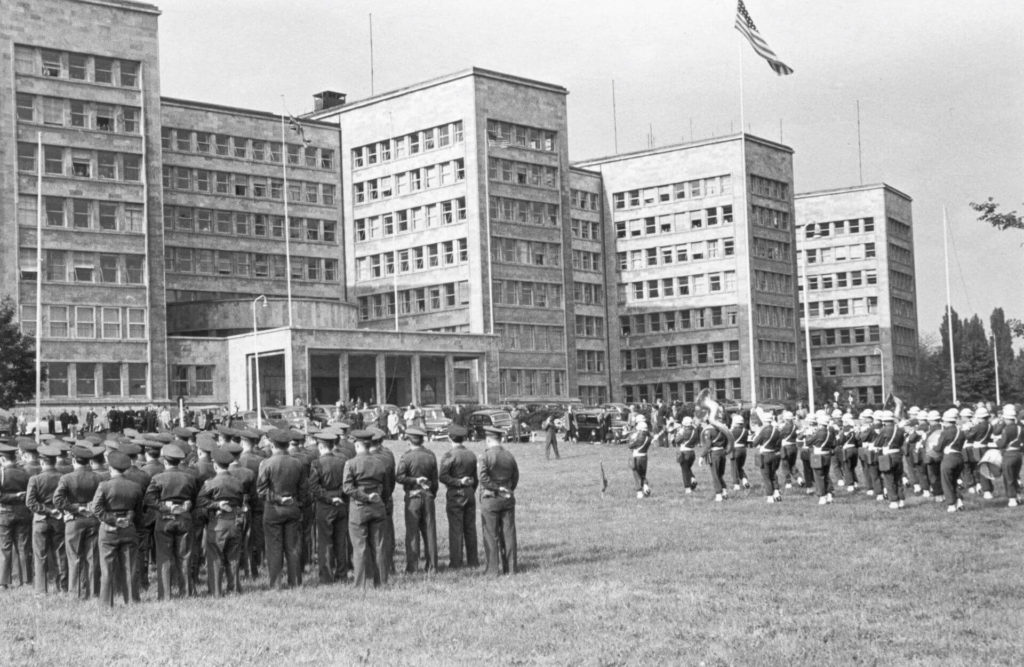
The path to the first draft Basic Law
The Western occupying powers provided the decisive impetus from the very beginning. With the “Frankfurt Documents,” they instructed the West German minister presidents in March 1948 to convene a constituent assembly to form a western state.
Conferences at the Rittersturz and in Niederwald
From July 8 to 10, 1948, the West German minister presidents and the provisional mayor of Berlin discussed the Frankfurt documents at the Rittersturz Hotel. The central issue was the problem of not formally establishing the division of Germany, which had in fact already been completed. The Koblenz resolutions set out the solution planned by the minister presidents, namely that only a provisional organization of state action should be decided. However, the occupying powers rejected this.
It was only after further conferences at the Niederwald hunting lodge near Rüdesheim and intense negotiations with the occupying powers that the parties involved agreed to create a temporary arrangement in terms of space and time. In three sessions between July 15 and August 31, 1948, the eleven West German minister presidents and other political actors worked out the structures for the Basic Law of the Federal Republic of Germany. In order not to rule out German reunification in the future, constitutional terminology was of great importance: instead of a “Constituent Assembly,” a “Parliamentary Council” was to convene. Instead of “Constitution,” the term “Basic Law” was to be chosen.
Constitutional Convention at Herrenchiemsee
The Niederwald Conference was followed on August 11 by the Constitutional Convention at Herrenchiemsee. The resulting draft constitution had a decisive influence on the drafting of the Basic Law in the Parliamentary Council.
The work of the Parliamentary Council in Bonn
The Parliamentary Council was elected by the state parliaments in August 1948 and convened in Bonn on September 1, 1948. Only four of the 65 members were women: Friederike Nadig, Elisabeth Selbert, Helene Wessel, and Helene Weber. Today, they are regarded as the “mothers” of the Basic Law, and were decisive in the adoption of the third article of the Basic Law “Women and Men are Equal.” Konrad Adenauer was elected President of the Council.
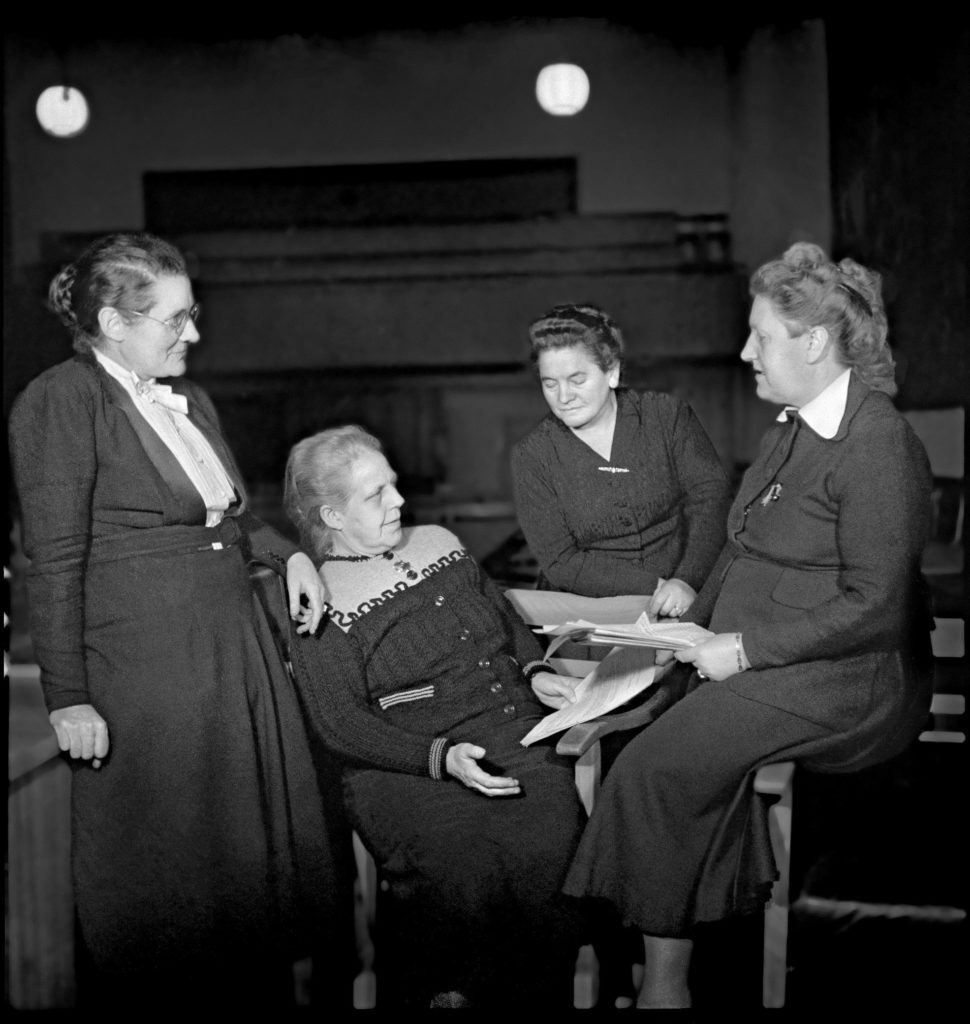
After nine months of work – exactly four years after the end of the Second World War – the Parliamentary Council presented the Basic Law on May 8, although it still depended on the approval of the military governors of the Western zones and the approval of the state parliaments. The military governors endeavored to ensure prompt ratification, as General Lucius Clay was scheduled to leave his post and return to America.
Frankfurt as a place of democratic history: The military government


The military governors
The military administration in Germany was headed by the military governors of the three Western Allies: the United States, Great Britain, and France. In May 1949, these were Lucius D. Clay, Sir Brian H. Robertson, and Pierre Kœnig.
Lucius D. Clay was one of those who advised against a strict occupation policy as early as 1945. Instead, he promoted an export-oriented industrial policy and the formation of the Bizone, accelerated democratization in his area of responsibility, and was the initiator of the Berlin Airlift in 1948/49.
Brian H. Robertson was the deputy military governor from May 1946 and military governor of the British occupation zone from November 1947 to May 1949. In this second function, he played a decisive role in the territorial conception of the state of North Rhine-Westphalia.
After the end of the war, Marie-Pierre Kœnig was commander-in-chief of the French occupation forces in Germany from July 1945 to September 1949 and at the same time military governor of the French occupation zone. Politically, he was committed to the unification of the Saar region with France. He was skeptical about the possibility of democratizing Germany.
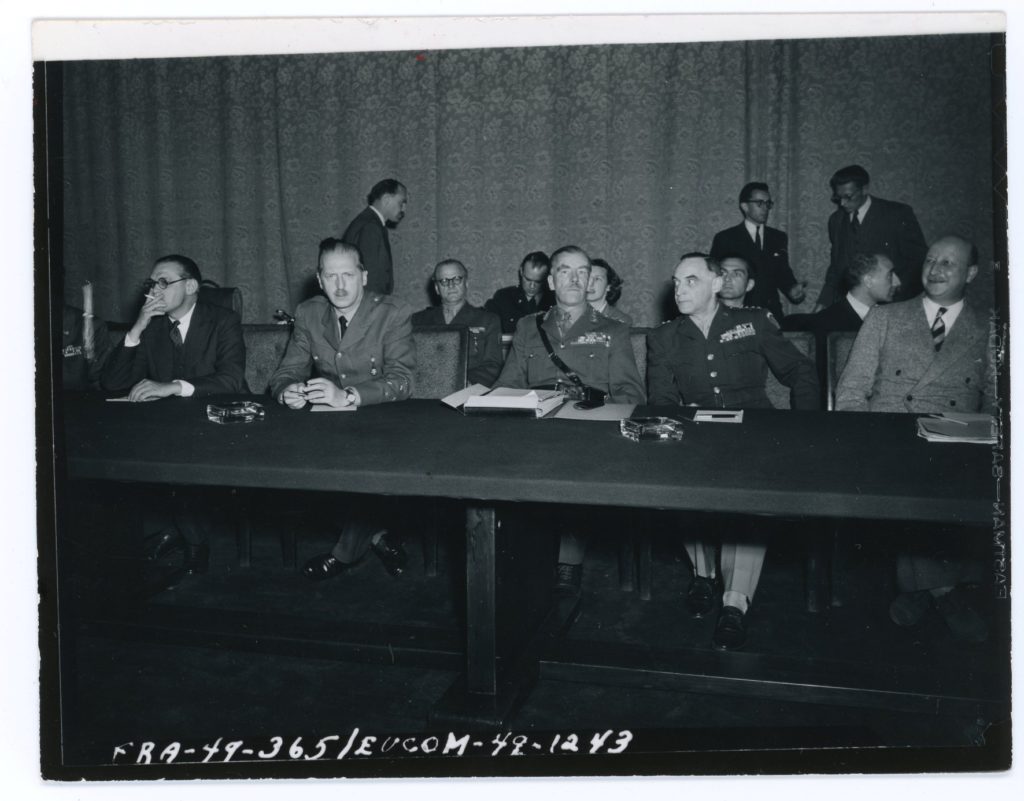
Although Frankfurt had not been elected as the “provisional capital city” and seat of parliament and government on May 10, the city nevertheless played an important role on the road to the Basic Law. In front of a delegation from the parliamentary council, the military governors of the three western occupation zones, Lucius D. Clay (USA), Sir Brian H. Robertson (UK) and Pierre Kœnig (France) approved he Basic Law in the IG Farbenhaus on May 12, 1949.
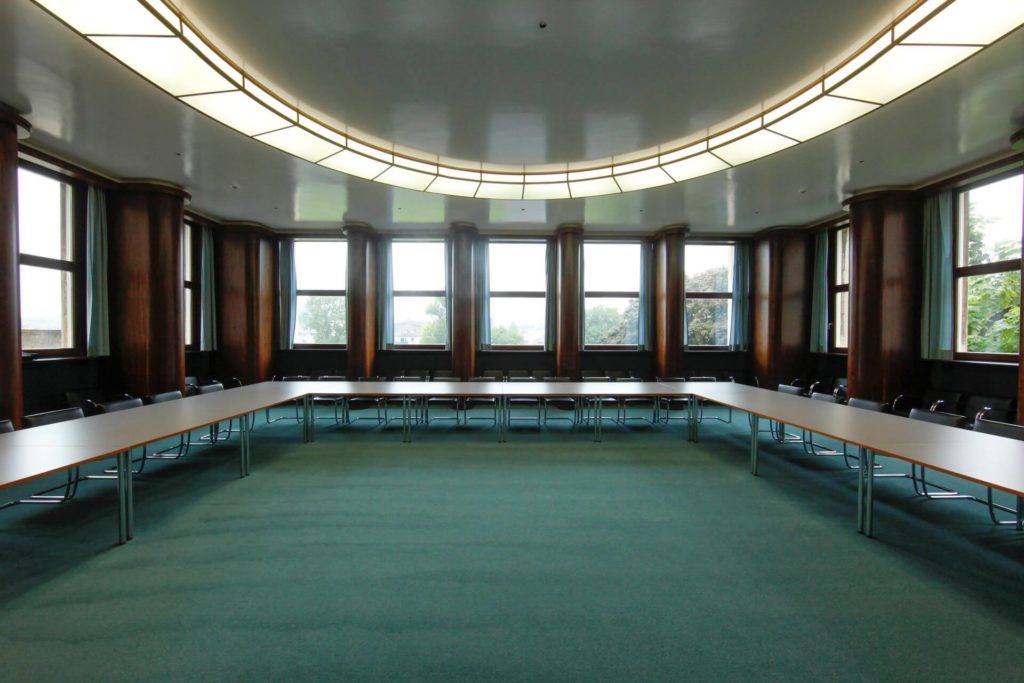
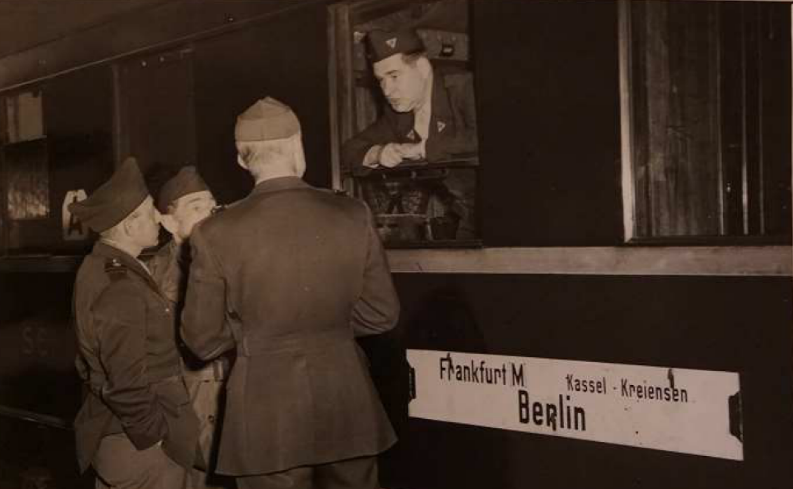
On the same day, in the night from May 11 to 12, the Soviet Union had ended the blockade of the three western sectors of Berlin, the so-called Berlin Blockade. The military governors were no longer in Berlin when the blockade was lifted, as they had made their way to Frankfurt to sign the Basic Law. During the blockade, supplies to Berlin were ensured by an airlift from Frankfurt.
Approval by the federal states
The Basic Law was adopted by the state parliaments between May 18 and 21. Only the Bavarian state parliament rejected the Basic Law. The deputies of the Free State had called for stronger federalism but accepted the validity of the provisional federal constitution after all other state parliaments had agreed to it.
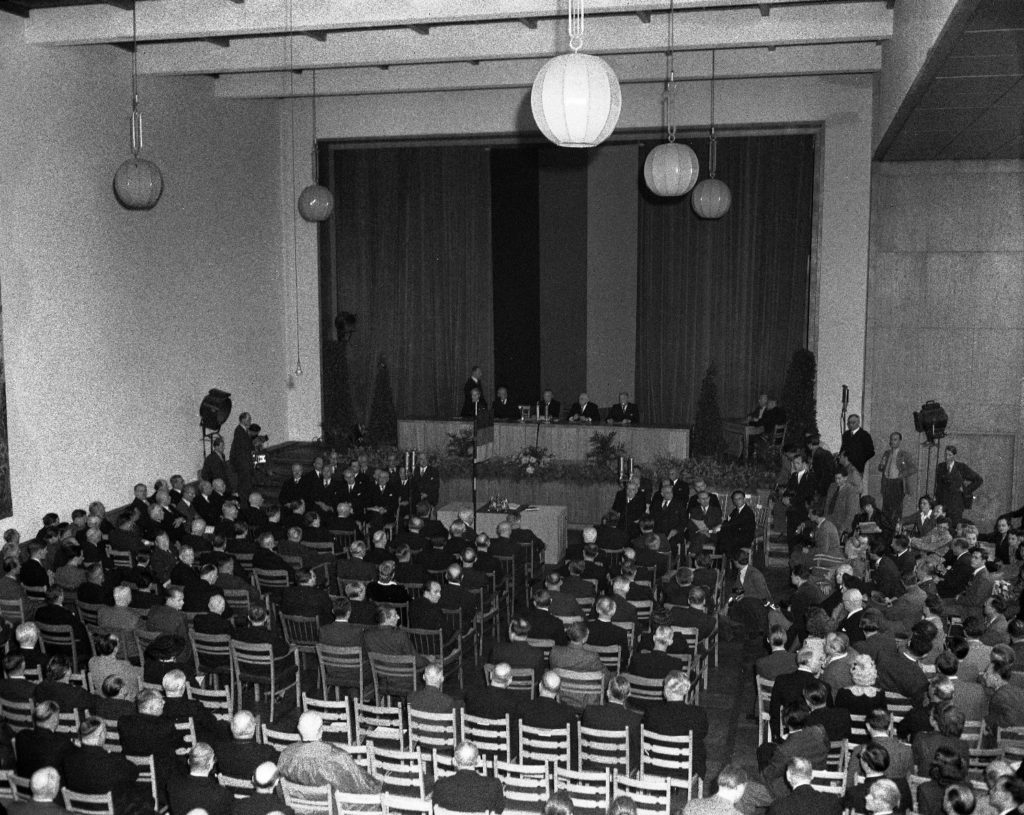
The signing of the German Basic Law
At its final session on May 23, 1949, the Parliamentary Council was able to announce that 14 months after the impulse to constitute the German West, the German Basic Law was a reality. The Federal Republic was thus founded.
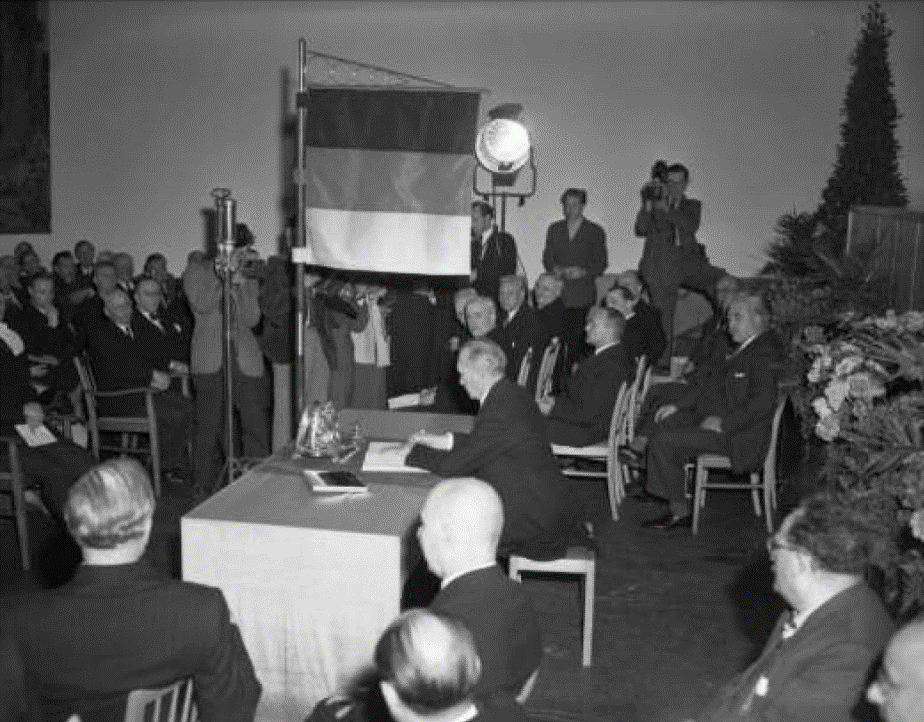
According to Article 20, it sees itself as a democratic and social federal state in which all state power emanates from the people. Legislation is bound by the constitutional order, while executive power and the administration of justice are bound by law and order. Since reunification, the Basic Law has applied to the entire territory of the Federal Republic of Germany.
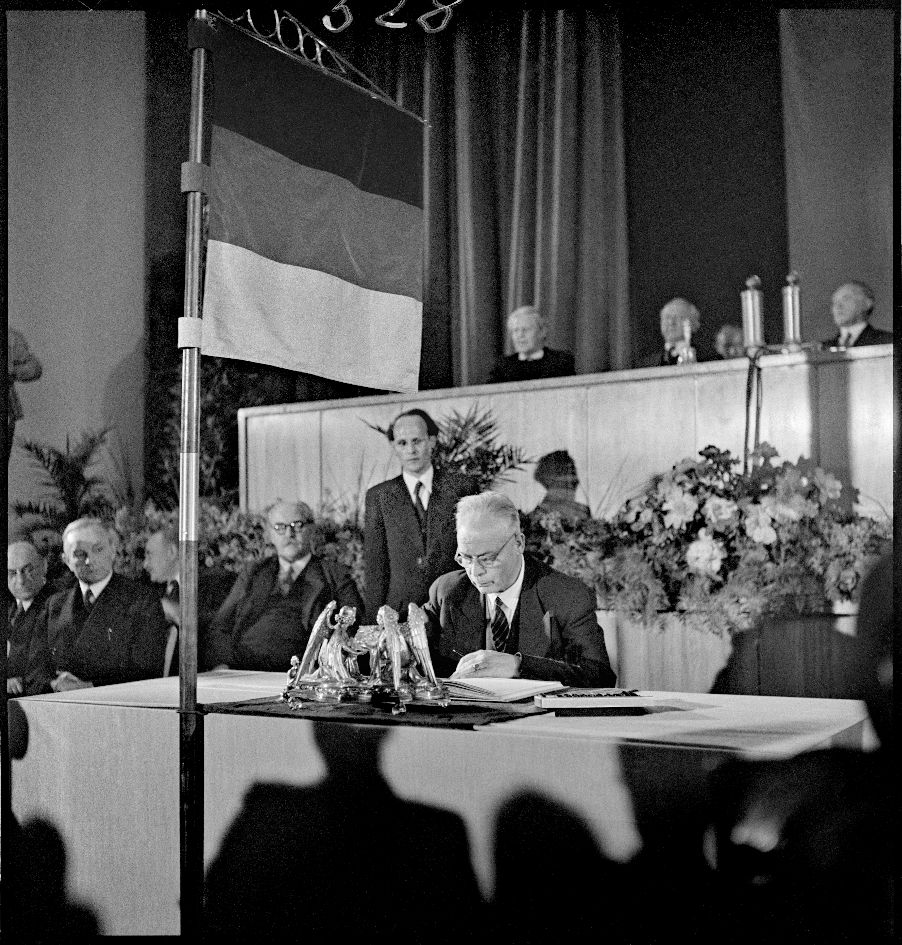
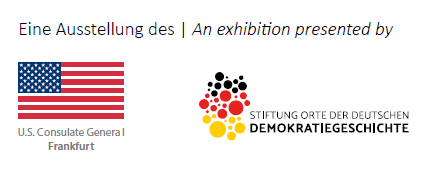


Bildquellen
- Ehemaliges IG-Farben Gebäude, heute Uni Frankfurt: Wikimedia Commons, GFDL 1.2
- Das Hauptquartier der amerikanischen Streitkräfte in Deutschland im ehemaligen IG-Farben-Gebäude in Frankfurt a. Main, Frühjahr 1949: bpk-Bildagentur, Foto: Benno Wundshammer
- Die „Mütter des Grundgesetzes“: Bestand Erna Wagner-Hehmke, Stiftung Haus der Geschichte der Bundesrepublik Deutschland, Bonn
- General Brian H. Robertson beim Empfang von General Lucius D. Clay auf der Rhein-Main Airbase, 1948: Institut für Stadtgeschichte Frankfurt, S7Z 1948/184, Foto: Kurt Weiner
- General Lucius D. Clay (r) und General Pierre Koenig (l) am IG Farbenhaus: Mit freundlicher Bereitstellung durch John Provan, Foto: N.N.
- Dei drei Militärgouverneure am 12. Mai 1949: Mit freundlicher Genehmigung der National Archives, Washington, D.C., Foto: N/A.
- Eisenhower-Saal: Universitätsarchiv Frankfurt, Foto: Uwe Dettmar
- Abfahrt des ersten Zuges Frankfurt-Berlin nach Beendigung der Berlin-Blockade: Institut für Stadtgeschichte Frankfurt, S7FR/335, Foto: Egon Matthes
- Unterzeichnung des deutschen Grundgesetzes, Bonn, 23. Mai 1949: Mit freundlicher Genehmigung von John Provan, Foto: N.N.
- Konrad Adenauer unterzeichnet das deutsche Grundgesetz, Bonn, 23. Mai 1949: Mit freundlicher Genehmigung von John Provan, Foto: N.N.
- Hessischer Ministerpräsident Christian Stock unterzeichnet das deutsche Grundgesetz, Bonn, 23. Mai 1949: Bestand Erna Wagner-Hehmke, Stiftung Haus der Geschichte der Bundesrepublik Deutschland, Bonn
